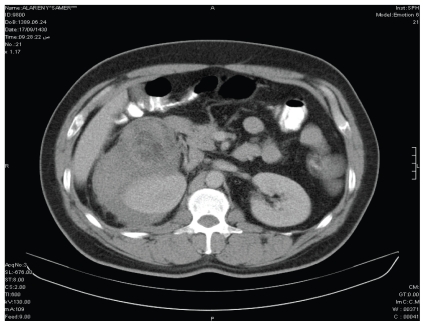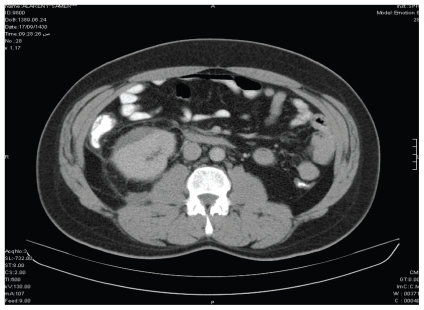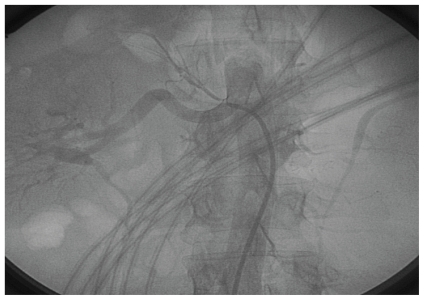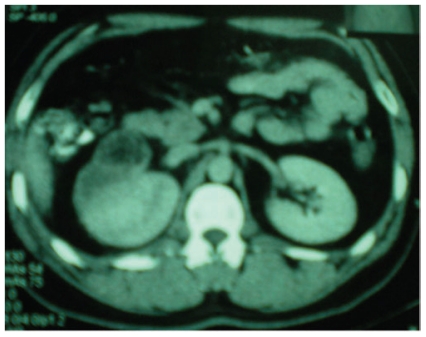Abstract
Background
Spontaneous rupture of adrenal pheochromocytoma is an extremely rare condition that can be lethal. Optimal treatment in these cases is still unclear.
Methods
We conducted a comprehensive review of medline articles on ruptured pheochromocytomas to locate all research done on this topic. Based on the literature review and one additional case at European Gaza Hospital, we analyzed clinical presentations, hemorrhage site, tumour side, mortality rate, and treatment options.
Results
In addition to our case, we identified 53 cases of ruptured pheochromocytoma. A review of all 53 cases revealed that 17 (32%) of the patients died, and that no mortality occurred among the 12 patients who received an alpha-blocker (to control high blood pressure) and fluid infusion therapy before surgery. Only 3 patients, including our case, underwent elective surgery after transcatheter arterial embolization (tae).
Conclusions
Surgical treatment should be considered for ruptured pheochromocytoma. Surgical approaches involve either emergency or elective surgery. It has been reported that emergency surgery is commonly associated with a high mortality rate; no deaths were reported in patients who underwent elective surgery. We therefore consider that, if a patient has hemodynamic instability, tae can be an effective and a safe procedure for achieving hemostasis and maintaining the patient in good condition until surgery can be performed.
Keywords: Adrenal pheochromocytoma, rupture, arterial embolization, treatment
1. INTRODUCTION
Adrenal pheochromocytomas are uncommon catecholamine-secreting tumours. In general out-patient clinics, the prevalence of pheochromocytoma in patients with hypertension is 0.1%–0.6% 1–3. The classic triad of pheochromocytoma presentation is episodic headache, sweating, and palpitations. Pheochromocytoma is typically found with a diverse set of symptoms, which may include anxiety, chest and abdominal pain, visual blurring, papilloedema, nausea and vomiting, orthostatic hypotension, and transient electrocardiographic changes 4. Spontaneous rupture of adrenal pheochromocytoma is extremely rare, with only about 50 cases reported in the literature to the date of writing 5. The mechanism of pheochromocytoma rupture is unknown, but high intracapsular pressure may tear the capsule and cause necrosis of the tumour 6.
Here, we describe a patient with ruptured right adrenal pheochromocytoma presenting with hypertension and abdominal pain, and we review the literature for similar cases. To best of our knowledge, this case is the first to be reported showing ruptured adrenal tumour with large retroperitoneal and subcapsular hematoma of the right kidney and with safe coil embolization for the adrenal and renal arteries.
2. CASE DESCRIPTION
A 42-year-old Palestinian man referred to the European Gaza Hospital emergency room presented with sudden onset of right-side upper abdominal pain radiating to the right flank and accompanied by sweating and palpitations for the preceding 24 hours.
In the 2 weeks before this presentation, the patient had recurrently experienced similar symptoms. He had been admitted to another hospital, where he underwent an urgent abdominal computed tomography (ct) scan with contrast, which demonstrated a large tissue mass in the right adrenal gland region with intracapsular bleeding and a large hematoma in the right retroperitoneal space (Figure 1) and subcapsular hematoma in the right kidney (Figure 2). At that time, he was urgently referred to Egypt, but unfortunately, he was denied entry.
FIGURE 1.
Right adrenal mass with retroperitoneal hematoma and intratumoral bleeding.
FIGURE 2.
Subcapsular hematoma in the right kidney.
The patient was then referred to our hospital. On admission, his blood pressure was 170/120 mmHg, and his pulse, 105 bpm. A complete blood count revealed elevated white cells (10,200/μL), hemoglobin (10.2 g/dL), hematocrit (38.3%), and platelets (415,000/mL). Blood chemistry showed some abnormal values: total protein, 8.4 g/dL; serum albumin, 5.1 g/dL; aspartate aminotransferase, 32 IU/L; alanine aminotransaminase, 41 IU/L; serum creatinine, 1.7 mg/dL; and fasting plasma glucose, 6.3 mmol/L. Urinalysis showed urinary protein 2+ and urinary occult blood 3+. Electrocardiography showed sinus tachycardia. Findings on chest radiography were within normal limits, with a cardiothoracic ratio of 50% and no lung abnormalities. The patient had no medical history of hypertension. Laboratory tests of 24-hour urine demonstrated high vanillylmandelic acid, at 31 mg in 24 hours (reference range: 1–10 mg).
We performed abdominal aortography using a right femoral approach. Selective angiograms of the celiac, superior mesenteric, and right renal artery were obtained, with subsequent selective cannulation of the right renal and adrenal arteries using a Judkins right 6 French catheter (Figure 3).
FIGURE 3.
Adrenal gland supply by medial and lateral branches of the right adrenal and renal artery.
Because of the subcapsular hematoma in the right kidney, urinary protein 2+, urinary occult blood 3+, an arterial supply of the right suprarenal gland was performed from the right renal and medial and lateral suprarenal arteries. With back and abdominal pain and hypertension continuing despite medical treatment, the patient was at high risk for surgery. We therefore suggested transcatheter arterial embolization (tae) for the renal and suprarenal arteries.
A tae using coils was then performed on the medial and lateral branches of the right adrenal and renal artery using 3 French microcatheters. Subsequent dye injection demonstrated complete obliteration of the tumour’s vascular supply. Immediately after embolization, the patient’s vital signs stabilized, and his blood pressure normalized to 130/90 mmHg. After 48 hours, his abdominal and flank pain had completely resolved.
A follow-up abdominal ct examination 2 weeks post tae showed significant resolution of the retroperitoneal hematoma. In addition, the tumour was also better delineated than it had been in the imaging done before the tae procedure (Figure 4).
FIGURE 4.
Significant resolution of the retroperitoneal hematoma.
One month after the coil tae, the patient underwent elective right adrenalectomy and nephrectomy. Pathology findings confirmed the diagnosis of pheochromocytoma. The adrenal gland tumour was composed of cells possessing round nuclei and abundant eosinophilic cytoplasm, arranged in a Zellballen pattern. Hemosiderin pigmentation and coagulation necrosis were frequently seen.
3. LITERATURE REVIEW
Since the first description of ruptured pheochromocytoma by Cahill in 1944 7, a total of 53 cases, including the present one, have been reported in the literature. No difference in frequency between men and women has been reported, and median age of the patients was 50.1 years. Table I summarizes the 53 cases 8–56.
TABLE I.
Clinical characteristics of 53 patients with spontaneous ruptured pheochromocytoma
| Characteristic | Value |
|---|---|
| Age (years) | |
| Median | 50.1 |
| Range) | 15–80 |
| Sex (n) | |
| Male | 27 |
| Female | 26 |
| Tumour location [n (%)] | |
| Right | 30 (56.6) |
| Left | 22 (41.5) |
| Bilateral | 1 (1.9) |
| Symptoms [n (%)]a | |
| Acute abdomen | 42 (79) |
| Shock | 30 (57) |
| Lumbar pain | 13 (24.5) |
| Chest pain | 10 (19) |
| Surgical setting [n (%)] | |
| Emergency | 29 (55) |
| Elective | 12 (23) |
| Elective surgery after tae | 3 (5) |
| Not performed | 9 (17) |
| Hemorrhage site [n (%)] | |
| Inside tumour | 13 (25) |
| Rupture | |
| Retroperitoneal | 27 (51) |
| Intraperitoneal | 13 (24) |
| Outcome [n (%)] | |
| Survived | 36 (68) |
| Died | 17 (32) |
Multiple symptoms reported when applicable.
tae = transcatheter arterial embolization.
3.1. Presentation
Analysis of the literature shows that 79% of the patients presented with acute abdominal pain, 19% with chest pain, 24.5% with lumbar pain, and 57% with shock. One case presented with acute myocardial infarction 52.
3.2. Treatment
Surgical excision was performed in 44 cases. In 12 patients, the surgery was elective after the patient had been stabilized with an alpha-blocker (to control high blood pressure) and fluid infusion therapy. In 3 patients, the surgery was elective after tae. In 29 cases, the surgery was emergent, and in 9 patients, surgery was not performed.
3.3. Outcome
The mortality rate was high: one third of the patients [17 (32%)] died. No mortality occurred among the 15 patients who received alpha-blocker and fluid infusion therapy, or who were treated by tae before elective surgery. All 17 who died were among the 38 patients (44.7%) who did not undergo elective surgery after appropriate medical preparation.
3.4. Transcatheter Arterial Embolization
The literature shows that only 3 patients (including our case) underwent elective surgery after tae (Table II):
TABLE II.
Summary of the 3 cases of ruptured pheochromocytoma treated with transcatheter arterial embolization (tae)
| Case |
|||
|---|---|---|---|
| 1 | 2 | 3 | |
| Age (years) | 67 | 32 | 42 |
| Sex | Male | Male | Male |
| Tumour location | Right | Right | Right |
| Embolization material | Polyvinyl alcohol particles | Coils | Coils |
| Time of surgery after tae | 2 Months | 21 Days | 1 Month |
| Hemorrhage site | Retroperitoneal | Intratumoral | Retroperitoneal; subcapsular in the right kidney and intratumoral |
Case 1
A 67-year-old man was admitted to the emergency department with a 1-day history of severe right abdominal and back pain associated with diaphoresis, nausea, and vomiting. Imaging by ct demonstrated a right adrenal mass with retroperitoneal hemorrhage. A tae using polyvinyl alcohol particles was done to the right adrenal artery, and 2 months later, the patient underwent elective right adrenalectomy 53.
Case 2
A 32-year-old man presented with sudden right abdominal pain, and urgent ct imaging demonstrated a bilateral adrenal mass with hemorrhage in the right adrenal mass. Coil embolization was done to the right adrenal artery, and 21 days later, resection of the right adrenal gland was performed 54.
Case 3 (present case)
A 42-year-old man with a large retroperitoneal hematoma, hemorrhage in the right adrenal mass, and hypertension underwent tae by coils to the right renal and the adrenal arteries to achieve hemostasis. Surgery was performed 1 month later.
4. DISCUSSION
Pheochromocytomas are uncommon catecholamine-secreting tumours. Rupture of an adrenal pheochromocytoma is extremely rare and can be lethal because of dramatic changes in the circulation.
The exact mechanism of pheochromocytoma rupture is unknown, but high blood pressure attributable to a massive release of catecholamine into the circulation is probably associated with vasoconstriction in the tumour and subsequent necrosis, hemorrhage, and elevated intracapsular pressure. Additionally, rapid tumour growth may contribute to high intracapsular pressure. High pressure in the intracapsular region may also result in a tear in the capsule, causing retroperitoneal hemorrhage.
Abdominal pain may be related to stimulation of alpha-adrenergic receptors, constriction of intestinal vascular smooth muscle, and contraction of the ileocolic sphincter. High levels of circulating catecholamines will therefore result in a decrease of intestinal motility and tone 55.
The application of tae allows for hemostasis, with consolidation of the hematoma; surgery can subsequently be performed easily and without complications 56.
5. CONCLUSIONS
When adrenal pheochromocytoma has been diagnosed, surgical treatment should be considered. Surgical approaches for ruptured pheochromocytoma involve either emergent or elective surgery. Immediate surgery is associated with a high mortality rate (44.7%); no mortality has been reported in patients who undergo elective surgery after good blood pressure and total body water control has been achieved using alpha-adrenergic blocker and f luid infusion therapy, or after stabilization by tae.
Phentolamine mesylate is a useful alpha-adrenergic blocker to control blood pressure in patients with pheochromocytoma. If initial conservative therapy can control retroperitoneal hemorrhage and blood pressure, a watch-and-wait approach is safe and less invasive for the patient, avoiding the risk of re-bleeding. If, despite medical treatment, the patient is unstable because of uncontrolled blood pressure or recurrent abdominal pain or persistent bleeding, we therefore conclude that tae should be the first treatment option in the attempt to achieve hemostasis before surgery—an approach that should reduce mortality and maintain the patient in good condition.
6. REFERENCES
- 1.Anderson JH, Jr, Blakeman N, Streeten DH. The effect of age on prevalence of secondary forms of hypertension in 4429 consecutively referred patients. J Hypertens. 1994;12:609–15. doi: 10.1097/00004872-199405000-00015. [DOI] [PubMed] [Google Scholar]
- 2.Omura M, Saito J, Yamaguchi K, Kakuta Y, Nishikawa T. Prospective study on the prevalence of secondary hypertension among hypertensive patients visiting a general outpatient clinic in Japan. Hypertens Res. 2004;27:193–202. doi: 10.1291/hypres.27.193. [DOI] [PubMed] [Google Scholar]
- 3.Sinclair AM, Isles CG, Brown I, Cameron H, Murray GD, Robertson JW. Secondary hypertension in a blood pressure clinic. Arch Intern Med. 1987;147:1289–93. [PubMed] [Google Scholar]
- 4.Adler JT, Meyer–Rochow GY, Chen H, et al. Pheochromocytoma: current approaches and future directions. Oncologist. 2008;13:779–93. doi: 10.1634/theoncologist.2008-0043. [DOI] [PubMed] [Google Scholar]
- 5.Kobayashi T, Iwai A, Takahashi R, Ide Y, Nishizawa K, Mitsumori K. Spontaneous rupture of adrenal pheochromocytoma: review and analysis of prognostic factors. J Surg Oncol. 2005;90:31–5. doi: 10.1002/jso.20234. [DOI] [PubMed] [Google Scholar]
- 6.Mayumi M, Haruhiro S, Mitsunori Y, Sunao SH, Toshiro T, Robert YO. Spontaneous rupture of pheochromocytoma and its clinical features: a case report. Tokai J Exp Clin Med. 2008;33:110–15. [PubMed] [Google Scholar]
- 7.Cahill GF. Sympathoblast. Pheochromoblast. Pennsylvania Med J. 1994;47:664–7. [Google Scholar]
- 8.Lehman DJ, Jr, Rosof J. Massive hemorrhage into an adrenal pheochromocytoma. N Engl J Med. 1956;254:474–6. doi: 10.1056/NEJM195603082541007. [DOI] [PubMed] [Google Scholar]
- 9.Plouin PF, Duclos JM, Soppelsa F, Boublil G, Chatellier G. Factors associated with perioperative morbidity and mortality in patients with pheochromocytoma: analysis of 165 operations at a single center. J Clin Endocrinol Metab. 2001;86:1480–6. doi: 10.1210/jcem.86.4.7392. [DOI] [PubMed] [Google Scholar]
- 10.Saltz NJ, Lutwak EM, Schwartz A, Goldberg AM. Danger of aortography in the localization of phechromocytoma. Ann Surg. 1956;144:118–23. doi: 10.1097/00000658-195607000-00017. [DOI] [PMC free article] [PubMed] [Google Scholar]
- 11.Brody IA. Shock after administration of prochlorperazine in patient with pheochromocytoma. J Am Med Assoc. 1959;169:1749–52. doi: 10.1001/jama.1959.73000320003013a. [DOI] [PubMed] [Google Scholar]
- 12.Huston JR, Stewart WR. Hemorrhagic pheochromocytoma with shock and abdominal pain. Am J Med. 1965;39:502–4. doi: 10.1016/0002-9343(65)90217-2. [DOI] [PubMed] [Google Scholar]
- 13.McAlister WH, Koehler PR. Hemorrhage into a pheochromocytoma in a patient on anticoagulants. J Can Assoc Radiol. 1967;18:404–6. [PubMed] [Google Scholar]
- 14.Lawson DW, Corry RJ, Patton AS, Daggett WM, Austen WG. Massive retroperitoneal adrenal hemorrhage. Surg Gynecol Obstet. 1969;129:989–94. [PubMed] [Google Scholar]
- 15.Delaney JP, Paritzky AZ. Necrosis of a pheochromocytoma with shock. N Engl J Med. 1969;280:1394–5. doi: 10.1056/NEJM196906192802508. [DOI] [PubMed] [Google Scholar]
- 16.Nyman D, Wahlberg P. Necrotic phaeochromocytoma with gastric haemorrhage, shock, and uncommonly high catecholamine excretion. Acta Med Scand. 1970;187:381–3. doi: 10.1111/j.0954-6820.1970.tb02959.x. [DOI] [PubMed] [Google Scholar]
- 17.Delaney PV, Mungall IP. Bilateral malignant phaeochromocytomas presenting as massive retroperitoneal haemorrage. J Ir Med Assoc. 1971;64:428–9. [PubMed] [Google Scholar]
- 18.Rymaszewski Z, Wocial B, Feltynowski T, Michalowicz B, Malanowska S. Case of pheochromocytoma complicated by necrosis with hemorrhage into the retroperitoneal space and shock [Polish] Pol Arch Med Wewn. 1976;56:171–8. [PubMed] [Google Scholar]
- 19.Van Way CW, 3rd, Faraci RP, Cleveland HC, Foster JF, Scott HW., Jr Hemorrhagic necrosis of pheochromocytoma associated with phentolamine administration. Ann Surg. 1976;184:26–30. doi: 10.1097/00000658-197607000-00004. [DOI] [PMC free article] [PubMed] [Google Scholar]
- 20.Atuk NO, Teja K, Mondzelewski P, Turner SM, Selden RF. Avascular necrosis of pheochromocytoma followed by spontaneous remission. Arch Intern Med. 1977;137:1073–5. [PubMed] [Google Scholar]
- 21.van Royen EA, Alberts C, de Vos R, Becker AE. Pheochromocytoma as a cause of “acute abdomen” [Dutch] Ned Tijdschr Geneeskd. 1978;122:573–7. [PubMed] [Google Scholar]
- 22.Nicholls K. Massive adrenal haemorrhage complicating adrenal neoplasm. Med J Aust. 1979;2:560–2. doi: 10.5694/j.1326-5377.1979.tb127181.x. [DOI] [PubMed] [Google Scholar]
- 23.Bednarski Z. Pheochromocytoma as a cause of fatal abdominal hemorrhage [Polish] Pol Tyg Lek. 1981;36:531–2. [PubMed] [Google Scholar]
- 24.Scott HW., Jr Emergencies in endocrine surgery. J Ky Med Assoc. 1983;81:825–30. [PubMed] [Google Scholar]
- 25.Greatorex RA, Raftery AT. Intraperitoneal rupture of a phaeochromocytoma. J R Soc Med. 1984;77:513–14. doi: 10.1177/014107688407700614. [DOI] [PMC free article] [PubMed] [Google Scholar]
- 25.Jones DJ, Durning P. Phaeochromocytoma presenting as an acute abdomen: report of two cases. Br Med J. 1985;291:1267–8. doi: 10.1136/bmj.291.6504.1267. [DOI] [PMC free article] [PubMed] [Google Scholar]
- 26.Lee PH, Blute R, Jr, Malhotra R. A clinically “silent” pheochromocytoma with spontaneous hemorrhage. J Urol. 1987;138:1429–32. doi: 10.1016/s0022-5347(17)43663-9. [DOI] [PubMed] [Google Scholar]
- 27.Shaw TR, Rafferty P, Tait GW. Transient shock and myocardial impairment caused by phaeochromocytoma crisis. Br Heart J. 1987;57:194–8. doi: 10.1136/hrt.57.2.194. [DOI] [PMC free article] [PubMed] [Google Scholar]
- 28.Lago Montero A, Silva Abuin J, Gómez Zancajo VR, Montero Gómez J. Massive retroperitoneal hemorrhage as the first manifestation of a pheochromocytoma [Spanish] Arch Esp Urol. 1986;39:269–73. [PubMed] [Google Scholar]
- 29.Forty J, Dale RF. Ruptured phaeochromocytoma: a case report. J R Coll Surg Edinb. 1989;34:109–10. [PubMed] [Google Scholar]
- 30.Sue–Ling HM, Foster ME, Wheeler MH, McMahon MJ. Spontaneous rupture of phaeochromocytoma mimicking leaking aortic aneurysm. J R Soc Med. 1989;82:53–4. doi: 10.1177/014107688908200125. [DOI] [PMC free article] [PubMed] [Google Scholar]
- 31.Vermeulen C, Valensi P, Amouroux J, Debien M. Spontaneous retroperitoneal hemorrhagic rupture of pheochromocytoma. A rapidly lethal case [French] Ann Med Interne (Paris) 1989;140:327–30. [PubMed] [Google Scholar]
- 32.Terai A, Terachi T, Yoshida S, Kadota K. Pheochromocytoma presenting as shock and followed by spontaneous remission. Urol Int. 1989;44:58–60. doi: 10.1159/000281455. [DOI] [PubMed] [Google Scholar]
- 33.Terachi T, Terai A, Yoshida S, Yokota K, Fukunaga M. Spontaneous rupture of adrenal pheochromocytoma: a case report. Urol Int. 1989;44:235–7. doi: 10.1159/000281511. [DOI] [PubMed] [Google Scholar]
- 34.Spencer E, Pycock C, Lytle J. Phaeochromocytoma presenting as acute circulatory collapse and abdominal pain. Intensive Care Med. 1993;19:356–7. doi: 10.1007/BF01694713. [DOI] [PubMed] [Google Scholar]
- 35.Hatada T, Nakai T, Aoki I, et al. Acute abdominal symptoms caused by hemorrhagic necrosis of a pheochromocytoma: report of a case. Surg Today. 1994;24:363–7. doi: 10.1007/BF02348569. [DOI] [PubMed] [Google Scholar]
- 36.Tanaka K, Noguchi S, Shuin T, Kinoshita Y, Kubota Y, Hosaka M. Spontaneous rupture of adrenal pheochromocytoma: a case report. J Urol. 1994;151:120–1. doi: 10.1016/s0022-5347(17)34886-3. [DOI] [PubMed] [Google Scholar]
- 37.Ong KL, Tan TH. Ruptured phaeochromocytoma—a rare differential diagnosis of acute abdomen. Singapore Med J. 1996;37:113–14. [PubMed] [Google Scholar]
- 38.Chelbus M, Lapinski M, Torbicki A, et al. Pheochromocytoma with hemorrhagic necrosis and rupture with symptoms of acute abdomen and shock [Polish] Pol Arch Med Wewn. 1996;96:58–61. [PubMed] [Google Scholar]
- 39.Quinonero Diaz A, Garcia Hirschfeld J, Alonso Dorrego JM, et al. Spontaneous rupture of pheochromocytoma in a patient with polycystic kidneys. Apropos of a case [Spanish] Arch Esp Urol. 1997;50:1117–19. [PubMed] [Google Scholar]
- 40.Sapienza P, Tedesco M, Graziano P, Moretti M, Mingazzini PL, Cavallaro A. An unusual case of spontaneous rupture of a clinically “silent” phaeochromocytoma. Anticancer Res. 1997;17:717–20. [PubMed] [Google Scholar]
- 41.Gullà N, Patriti A, Capitanucci L, Fabbri B, Patriti A, Tristaino B. A case of “silent” pheochromocytoma presenting as spontaneous retroperitoneal hematoma. Ann Ital Chir. 2000;71:735–7. [PubMed] [Google Scholar]
- 42.García Rodríguez J, Fernández Gómez JM, Rodríguez Martínez JJ, Rodríguez Faba O, Regadera Sejas J, Escaf Barmadah S. Spontaneous retroperitoneal hemorrhage caused by a pheochromocytoma [Spanish] Arch Esp Urol. 2002;55:955–8. [PubMed] [Google Scholar]
- 43.Sumino Y, Tasaki Y, Satoh F, Mimata H, Nomura Y. Spontaneous rupture of adrenal pheochromocytoma. J Urol. 2002;168:188–9. [PubMed] [Google Scholar]
- 44.Mohamed HA, Aldakar MO, Habib N. Cardiogenic shock due to acute hemorrhagic necrosis of a pheochromocytoma: a case report and review of the literature. Can J Cardiol. 2003;19:573–6. [PubMed] [Google Scholar]
- 45.Héron E, Chatellier G, Billaud E, Foos E, Plouin PF. The urinary metanephrine-to-creatinine ratio for the diagnosis of pheochromocytoma. Ann Intern Med. 1996;125:300–3. doi: 10.7326/0003-4819-125-4-199608150-00008. [DOI] [PubMed] [Google Scholar]
- 46.Mayo–Smith WW, Boland GW, Noto RB, Lee MJ. State-of-the- art adrenal imaging. Radiographics. 2001;21:995–1012. doi: 10.1148/radiographics.21.4.g01jl21995. [DOI] [PubMed] [Google Scholar]
- 47.Williams DT, Dann S, Wheeler MH. Phaeochromocytoma—views on current management. Eur J Surg Oncol. 2003;29:483–90. doi: 10.1016/s0748-7983(03)00071-4. [DOI] [PubMed] [Google Scholar]
- 48.Chan MK, Tse HW, Mok FP. Ruptured phaeochromocytoma—a lesson in acute abdomen. Hong Kong Med J. 2003;9:221–3. [PubMed] [Google Scholar]
- 49.Aplin SC, Yee KF, Cole MJ. Neonatal effects of long-term maternal phenoxybenzamine therapy. Anesthesiology. 2004;100:1608–10. doi: 10.1097/00000542-200406000-00039. [DOI] [PubMed] [Google Scholar]
- 50.Ulchaker JC, Goldfarb DA, Bravo EL, Novick AC. Successful outcomes in pheochromocytoma surgery in the modern era. J Urol. 1999;161:764–7. [PubMed] [Google Scholar]
- 51.Plouin PF, Duclos JM, Soppelsa F, Boublil G, Chatellier G. Factors associated with perioperative morbidity and mortality in patients with pheochromocytoma: analysis of 165 operations at a single center. J Clin Endocrinol Metab. 2001;86:1480–6. doi: 10.1210/jcem.86.4.7392. [DOI] [PubMed] [Google Scholar]
- 52.Chen HY. Ruptured pheochromocytoma presents as acute myocardial infarction. Am J Emerg Med. 2009;27:1018.e5–6. doi: 10.1016/j.ajem.2008.12.016. [DOI] [PubMed] [Google Scholar]
- 53.Pua U, Wong DE. Transarterial embolisation of spontaneous adrenal pheochromocytoma rupture using polyvinyl alcohol particles. Singapore Med J. 2008;49:e126–30. [PubMed] [Google Scholar]
- 54.Park JH, Kang KP, Lee SJ, Kim CH, Park TS, Baek HS. A case of a ruptured pheochromocytoma with intratumoral aneurysm managed by coil embolization. Endocr J. 2003;50:653–6. doi: 10.1507/endocrj.50.653. [DOI] [PubMed] [Google Scholar]
- 55.Sweeney AT, Malabanan AO, Blake MA, de las Morenas A, Cachecho R, Melby JC. Megacolon as the presenting feature in pheochromocytoma. J Clin Endocrinol Metab. 2000;85:3968–72. doi: 10.1210/jcem.85.11.6947. [DOI] [PubMed] [Google Scholar]
- 56.Hendrickson RJ, Katzman PJ, Queiroz R, Sitzmann JV, Koniaris LG. Management of massive retroperitoneal hemorrhage from an adrenal tumor. Endocr J. 2001;48:691–6. doi: 10.1507/endocrj.48.691. [DOI] [PubMed] [Google Scholar]






